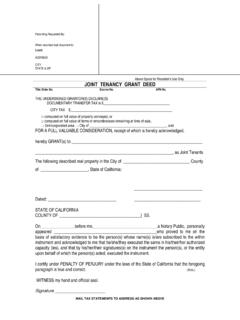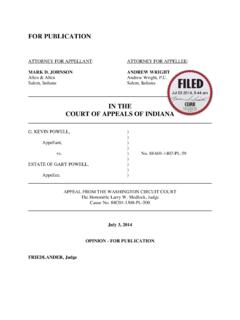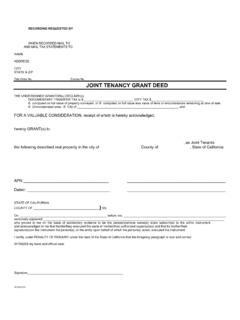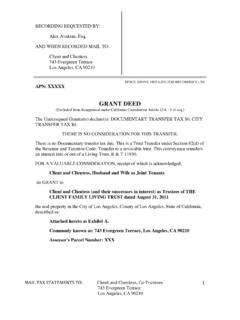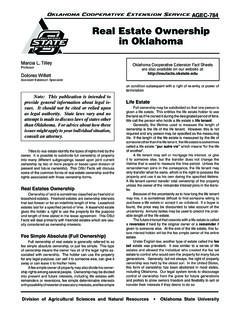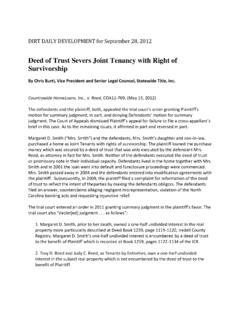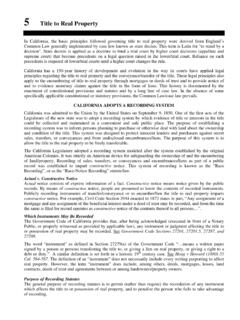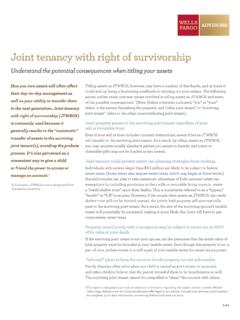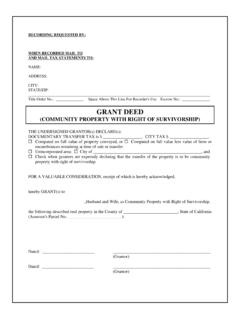Transcription of Estates and Interests in Real Property - Carruthers & Roth
1 Estates and Interests in real Property Elizabeth J. Zook. Esq. Carruthers & Roth, Possessory Estates Fee Simple Fee Tail Defeasible Fee Life Estates Possessory Estates Fee Simple No Special Words Required By statute, every conveyance or devise is presumed to create a fee simple estate unless the transferor s intent to create a lesser estate is clearly expressed in the instrument. As language and his heirs to convey a fee simple estate . Gen. Stat. 39-11. Possessory Estates Fee Simple Example: O conveys to A. Although at common law, A would have received only a life estate due to the omission of the words and his heirs, the statute results in A receiving the Property in fee simple. Possessory Estates Fee Simple Effect of Rule in Shelley s Case: By statute, North Carolina has abolished the Rule in Shelley s Case. The statute s operation, however, is prospective only; therefore, title transactions that took effect prior to October 1, 1987 remain subject to the rule.
2 Possessory Estates Fee Simple Example: O conveys to A for life, then to A s heirs. If the deed took effect on or after October 1, 1987, A receives only a life estate and his heirs have a contingent remainder in fee simple. If, however, the deed took effect prior to October 1, 1987, the rule would apply, with the result that A would receive both the life estate and the remainder in fee simple; these two Estates would then merge, and A would be deemed to hold title in fee simple and not merely for life. Possessory Estates Fee Tail North Carolina has effectively abolished the fee tail estate by virtue of a statute that provides that any person who would be seised of an estate in tail is deemed to be seised of an estate in fee simple. Gen. Stat. 41-1. Possessory Estates Fee Tail Example 1: O conveys to A and the heirs of his body. Although at common law A would have received merely a fee tail (and O would have retained a reversion), today as a result of the statute, A receives the Property in fee simple.
3 Possessory Estates Fee Tail Example 2: O devises Property to A and his children. Such a devise triggers application of the Rule in Wild s Case. If at the time the will becomes effective A has one or more children, A and such child(ren) will share the title in fee simple as tenants in common. However, if at the time the will becomes effective, A has no children, A takes the Property in fee tail; then, application of the statute results in A holding title in fee simple. Possessory Estates Defeasible Fee Three types of defeasible fee: Fee Simple Determinable Fee Simple on Condition Subsequent Fee Simple Subject to Executory Limitation Possessory Estates Defeasible Fee Fee Simple Determinable Fee Simple Determinable is created when words of duration ( while, so long as, until, etc.) are used to limit the estate in connection with a specified event Example: O conveys to A as long as the premises are used for residential purposes only, and when the Property is no longer so used, Property shall revert to the grantor.
4 A has a fee simple determinable. O, the grantor, has a possibility of reverter. Possibility of reverter must be expressly retained. Possessory Estates Defeasible Fee Fee Simple on Condition Subsequent Fee Simple on Condition Subsequent is created by (1) language of condition ( provided that, on condition that, etc.) together with an express right of entry or power of termination or (2) language providing that the conveyance is to be null and void if or is to be forfeited if a certain event occurs or fails to occur, Possessory Estates Defeasible Fee Fee Simple on Condition Subsequent Example: O conveys to A on condition that the premises be used for residential purposes only, and if the premises are ever used otherwise, the grantor shall have the right to reenter and repossess the premises. A has a fee simple on condition subsequent. O, the grantor, has a right of entry/power of termination. Possessory Estates Defeasible Fee Fee Simple on Condition Subsequent Language of Motive A clause in a deed will not be construed as a condition subsequent unless it clearly expresses that this is the intent of the parties.
5 A mere statement of the motive that induced the grantor to execute the deed is not sufficient to create a condition subsequent. Possessory Estates Defeasible Fee Fee Simple on Condition Subsequent For Discussion: O conveyed a tract of land to a church. The last line of the habendum clause in the deed contained the language for church purposes only. What kind of title did the church acquire from O? Possessory Estates Defeasible Fee Fee Simple on Condition Subsequent Termination of estate Fee Simple on Condition Subsequent does not terminate unless and until the grantor exercises his right of entry or power of termination AS OPPOSED TO: Fee Simple Determinable, which ends automatically on breach of the condition Possessory Estates Defeasible Fee Fee Simple Subject to Executory Limitation Provides that upon the happening of a specified event, the title will shift to a third party Example: O conveys Property to A, but if A dies without having married, then to B.
6 (B has executory interest ) Possessory Estates Defeasible Fee - Illegal or Void Conditions When the estate granted is defeasible, but the condition or event that would terminate it is illegal or against public policy, the estate is indefeasible as a result of the court s refusal to enforce it. Restraint on Marriage Restraint on Alienation of Property Possessory Estates Defeasible Fee - Illegal or Void Conditions Example: O conveys Property to A on condition that she not marry, but if she does, the estate will terminate and title will revert to the grantor. BUT: A Partial restraint on marriage is not void if it is incidental to another lawful purpose, such as providing for a surviving spouse only until remarriage. Possessory Estates Defeasible Fee Statutory Time Limitation A possibility of reverter, right of entry, or executory interest created on or after October 1, 1995 becomes invalid and the defeasible fee simple that precedes it becomes a fee simple absolute if a.
7 Future interest depends on an event affecting the use of the land, and b. The future interest does not actually vest in possession within 60 years after its creation. Possessory Estates Defeasible Fee Statutory Time Limitation Gen. Stat. 41-32 This rule does not apply to Interests held by a charity, a government or governmental agency, or to an arrangement relating solely to an interest in oil, gas, or minerals. Life Estates Language creating life estate : O conveys Property to A for life or any other language that makes it clear the estate is to last only for the lifetime of the grantee (A). O has a remainder interest . O conveys Property to A for the life of B creates life estate pur autre vie (for the life of another). Life Estates Rights of Life Tenant Entitled to all ordinary uses and profits from the land, as long as such use does not constitute waste. Right to Alienate Life tenant may transfer interest in the Property for any period that does not exceed the life interest the transferred interest will terminate upon the death of life tenant or the measuring life.
8 Life Estates Rights of Life Tenant Right to Convey Fee Simple Life tenant may convey fee simple interest in the Property only if given the power to do so, although life tenant s interest in the Property remains limited to the life estate . Thus, if Property is sold, life tenant is only entitled to value of the life estate , not value of the whole Property . Life Estates Rights of Life Tenant Right to Exploit Natural Resources Generally, life tenant does NOT have right to exploit such resources (timber, minerals, etc.) Exceptions: a. In reasonable amounts as necessary for repair and maintenance of the Property ; b. If expressly granted in the grant of the life estate ; c. If such resources were exploited prior to the grant of the life estate and grantor is considered to have intended that life tenant have the right to continue such exploitation. Life Estates Duties of Life Tenant Ordinary repairs vs. permissive waste No obligation to make permanent improvements, no right to reimbursement or contribution No duty to pay special assessments Affirmative duty to pay Property taxes or reimburse remainderman/reversioner interest on encumbrances up to income or annual rental value of the Property Concurrent Ownership tenancy in Common joint tenancy tenancy by the Entirety Concurrent Ownership tenancy in Common Created when Property is conveyed to two or more persons with language sufficient to show grantor intended the parties to have undivided Interests in the Property Also created when Property is inherited by the heirs of an intestate decedent.
9 Concurrent Ownership tenancy in Common O conveys to A and B O conveys to A and B Equally O devises to A and B O dies intestate and Property is inherited by A and B Concurrent Ownership Rights of Tenants in Common Right to Alienate Each tenant is free to convey, lease, or mortgage his interest in the common Property Tenant s share is inheritable under will or by intestate succession. Possession and Profits Each tenant is entitled to use and occupy all of the Property , but must not exclude co-owners (ouster), no compensation required, must account for profits If ouster occurs, ousted tenant may take legal action to restore possession and recover damages. Concurrent Ownership Rights of Tenants in Common Right to Partition Unless waived by agreement, each co-tenant is entitled to obtain partition of the common Property and own his share in severalty. Partition in kind actual physical division of the land into separate tracts Partition by sale sale of the entire Property , with proceeds divided among co-tenants according to their fractional Interests .
10 Co-tenant may waive right to partition for a reasonable time, either by an express or implied contract. Concurrent Ownership joint tenancy Grantor must use language in conveyance document that expressly provides for creation of a joint tenancy O conveys to A and B as joint tenants Otherwise, presumed to be tenancy in common Concurrent Ownership joint tenancy Inheritability Generally the same as for tenancy in common, except when right of survivorship has been created. interest of a deceased joint tenant is inheritable by heirs or beneficiaries, with a few exceptions: joint tenancy for business for profit joint tenancy for life tenancy by the entirety If document creating joint tenancy expressly provides for right of survivorship Concurrent Ownership joint tenancy Rule of Severance Where Property is owned by 3 or more persons in joint tenancy with right of survivorship, conveyance by one joint tenant to another party creates tenancy in common between the new party and the existing co-tenants.



